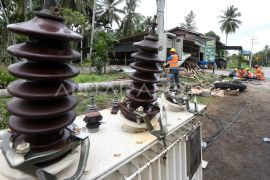“When covering an event, the outcome will not only be for newspapers, but also online editionsJakarta (ANTARA) - Today, it’s quite common to see a group of journalists flocking into a press room with their eyes staring at phone screens, while their hands frantically type news reports to be immediately dispatched to editors.
For an hour after an interview session with a few high-ranking officials, some online reporters would have sent at least four news reports.
However, they seem to be less than satisfied, because their employers set targets of publishing 10 to 11 news stories in a day. As a result, they keep scrolling through their interview transcripts searching for other angles that are worth exploring or even less than worth being published. Their objectives might no longer be to produce a good quality news report, but simply to create as many stories as possible.
While their minds and hands are occupied writing reports, a few of them have to deal with complaints from editors over spelling errors or incorrect information. Even though errors can be fixed before the editors publish the news, the reporters in the field may repeat the same mistake, considering the tight deadline and demanding targets from the office.
The narrative mentioned in paragraphs earlier is a common scenario in the working environment of most of Indonesia’s online reporters today.
However, reporters working for printed news outlets may face a different set of issues. Since thousands of news portals are thriving in the country for the past decade, most readers now prefer to read news online because it is free and more convenient.
As a result, only a few newspapers and magazines now remain in existence today and some of them have transformed into news portals or publish an electronic newspaper or e-paper.
Despite the differences, both groups of journalists have their own battles in adapting to the changing trend.
Related news: Smartphone alters news consumption behavior among generations
Related news: Defining role of News aggregators and consumers' independence
Change is hard but necessary
Although most printed news journalists still have faith in the existence of newspapers and magazines, they have slightly altered their working styles amid the change.
“When covering an event, the outcome will not only be for newspapers, but also online editions,” said Adrian Fajriansyah, a journalist of Harian Kompas, the Jakarta-based morning daily circulating nationwide.
However, he had a hard time fulfilling the demand. “My priority remains news articles for newspapers,” Fajriansyah said while adding that he preferred to publish more undated news features for the online edition because of the flexible deadline.
“On the online platform, the text must be complemented by photographs, video, and some graphics to make the final look attractive to readers. Therefore, it will take time,” he added.
Despite managing to juggle life on both platforms, the added assignments have put more pressure in his work-life balance, Fajriansyah admitted.

Meanwhile, Muhammad Irfan, a reporter of Pikiran Rakyat, a daily newspaper circulating in West Java and Banten provinces, said his newsroom now has also launched a news portal to adapt to the digital trend.
“I am aware that we (printed news reporters) are far behind in term of utilizing SEO (search engine optimization) and Google Trends. I have started using the tools now, but I see problems,” Irfan stated while explaining that there will be less important news being published but it would attract more viewers online.
In 2006, American multinational tech company, Google, launched Google Trends, a website providing “access to a largely unfiltered sample of actual search requests made to Google. It is anonymized (no one is personally identified), categorized (determining the topic
for a search query) and aggregated (grouped together). This allows us to display interest in a particular topic from around the globe or down to city-level geography,” the company said on its official website.
For the past few years, a large number of news portals in Indonesia have utilized the tool for gaining more viewers and readers online. Some of which include antaranews.com; kumparan.com; tirto.id; katadata.com.
Apart from Fajriansyah and Irfan, John Abi, a reporter of Koran Jakarta, a daily newspaper circulating in Jakarta, said, there was no difference in terms of the working style amid the change. “The platform may differ, but the news as content remains the same. We still refer to the similar norm and the journalist’s code of ethics when writing a news article,” Abi added.
What the future holds
Though many have claimed that digital will be the future of the news industry, some believe the printed publications such as newspapers and magazines will remain in existence, mainly in Indonesia where many regions are yet not covered by the Internet. “In many regions, local newspapers still thrive,” said Fajriansyah, who was also assigned to Aceh and North Sumatra provinces.
Moreover, news portals now have been challenged by the circulation of fake news, disinformation, and misinformation through social media platforms and websites. “News published in newspapers and magazines might be more reliable because we have more time to double-check facts, statements, and information,” Fajriansyah added.
However, a few of Indonesia’s news portals now publish investigative-style stories and in-depth news articles, such as Mongabay.co.id and Tirto.id. “If we look at more in-depth writing styles, many news portals have published these type of news articles,” Irfan said.
Related news: Media people should practice prophetic journalism: Observer
Related news: Rise Of Social Network, Citizen`s Journalism A Threat To Professional Journalists?
Editor: Mulyo Sunyoto
Copyright © ANTARA 2020












